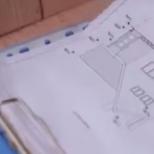How to make a polymer clay brooch. Brooch made of polymer clay "Mittens. Necessary materials and tools
IN Lately embroidered beaded brooches became very fashionable. Today I want to propose an idea of shining jewelry with a similar effect. Instead of beads, I took rhinestones, and used polymer clay as the base. The base is covered with rhinestones approximately like a gingerbread is covered with icing. Let's call such strass glaze strazirovka.
What kind of rhinestones can be used for this work? We need elements that won't melt in an oven at 130 degrees. It can be rhinestones made of glass, metal, a chain with rhinestones, metal pendants, glass cabochons, rivoli, etc. It should be borne in mind that glass and metal do not stick to polymer clay during the baking process, so it is better to buy rhinestones on an adhesive basis, the so-called thermal rhinestones. Elements without glue must either be glued after baking with superglue, or immured in clay before baking so that they do not come out. For example, a chain with rhinestones can be pressed in so that the jumper is inside the clay, and the rivoli can be removed and glued after baking.
Let's prepare a sketch first. You can print a picture from the Internet or draw a sketch by hand. Today we will make a heart. Below are some images of hearts. Choose what you like, print or draw yourself and cut out the resulting heart. When baked, polymer clay does not change size, so there is no need to make a template a little larger.

We start by preparing the foundation. Any baked polymer clay is suitable for rhinestones. I have Chinese DMO clay. On our live broadcasts in Vkontakte, the most frequently asked question about my review about the quality of Chinese clay. It is softer than more expensive counterparts, but flexible and durable after baking. DMO is perfect for rhinestones, because because of its softness it is easy to press rhinestones into it.

Layer polymer clay roll out with a rolling pin or on the thickest division of the pasta machine. We apply the template to the clay, circle it. Cut with a knife as close to the pattern as possible. You can use a dummy knife or a regular blade. After this, the edges of the brooch must be smoothed with your fingers along the entire contour, both from the front side and from the wrong side. The front side can even be flattened, depending on the design. We draw auxiliary lines according to the sketch. In order to glue rhinestones, you need to prepare a “tool”. We take a toothpick or a skewer, wrap cotton wool fibers on the very tip with a thin layer. Wet this cotton tip. When we apply the tip to the rhinestone, the rhinestone is glued to the fleece, carried onto the clay and slightly pressed into the surface.

We begin to apply rhinestones along the auxiliary lines. First the contours, and then we fill inside the contour. It is important to fill the space in such a way that there is not too much big gaps between the lines in which rhinestones do not fit.

Don't try to reproduce the drawing exactly. Even rhinestones laid out on paper will not give exact result. Customize the pattern as you work. Particular attention should be paid to the edge of the brooch. Carefully press the rhinestones located along the edge, because they are most subject to stress due to friction with clothing, etc.

After the drawing is ready, smooth the rhinestones with your finger to trim the height, press a little if the rhinestones stick out too much. We send for baking. Bake polymer clay brooches in a horizontal position. In a vertical position, when the glue melts, the rhinestones may slide off. If vertical surfaces are decorated, then the rhinestones need to be pressed in deeply so that they do not drain, in general, the rhinestones should be pressed in as much as possible so that they hold on tighter.
Chinese clay is baked at 130 degrees, thermostrass glue also melts at this temperature. If the product is well baked, the rhinestones will not peel off after hardening! If the brooch has cooled down and the rhinestones do not hold tightly, then the temperature is insufficient, bake the rhinestone brooch again.
Practice, make a few small samples and press rhinestones into them with different strengths. Bake and you will get an accurate idea of how hard you need to press the rhinestones and how long to bake the product.

After that, we fasten the clasp to the brooch blank as shown in the photo below.
Fragments of polymer clay can be fastened together with a special gel, but if it is not available, the fastener can be glued with epoxy. If the mount is on a gel, then the product needs to be baked again. In this case, you can put a brooch on a paper accordion so that the brooch is even, because the glue will melt again. I sanded the base a bit first. sandpaper giving it a rough texture.

Now about how to make a bulk polymer clay brooch. If you initially make the base of the brooch twice as thick, and then round off the edges by cutting off the excess, then you can get a three-dimensional heart (in the photo below, the two lower hearts are made in this way). Volumetric brooch looks very impressive.

Everything is ready, wear with pleasure!
I want to show you some photos with embroidered heart brooches from Pinterest. The authors are different, the brooches are embroidered with beads, but I know for sure that you will have ideas on how to make something original and original. Strazirovka technique provides a huge field for experimentation. Indeed, in the work you can use not only rhinestones, but also metal elements, stones, or you can decorate with modeling. What scope for imagination!






Feb 22, 2018 abraxams
Today we bring to your attention interesting master class to create original jewelry. Earrings and a brooch made of polymer clay look gentle, modern and stylish. We know that many of our readers love to sculpt with plasticine with their children. Modern mass for modeling is something. It is pleasant to the touch, and the variety of bright colors is simply pleasing. How much pleasure it gives the kids to crush a piece of such plasticine, especially since it is very useful for the development of fine motor skills of the hands. But they played around, put everything in tight-fitting boxes and put them away in their place. And we wanted to do something more durable. Then the idea came up, why not make something out of polymer clay. And in the hands of the material will have to be crushed to get the desired shape, but ready product after heat treatment it will please the eye for a long time. So we decided to make earrings and a brooch out of polymer clay in the shape of a flower. See what we got out of this venture.



Required materials and tools:
- polymer clay (it hardens during heat treatment);
- something for the middle (we used a vintage earring for the brooch, and small beads for the earrings);
- wax paper;
- oven for baking;
- Super glue;
- glaze for clay;
- something where you will attach earrings and a brooch (studs for earrings and a pin for a brooch, respectively).
Beginning of work
Prepare yourself workplace. Lay out the wax paper so you don't stain the table. When the product is ready, then right on this paper it can be placed in the oven. We take white polymer clay and knead a piece in our hands.

Flower shaping brooches
For the brooch, we roll 10 balls the size of the end of the thumb. For earrings, we also make 10 balls, but smaller.
In this master class, you will learn how to sculpt beautiful flowers and make a bright polymer clay brooch with your own hands.
Plastic jewelry looks very beautiful, lasts a long time, is not afraid of water and does not fade in the sun. The brooch is suitable for decorating clothes or bags. As a basis, you can also take a hair clip or a double universal mount. To prevent fingerprints from being left on the craft, be sure to work with medical gloves. The lesson is suitable for beginners.
Modeling materials
- metal base for a brooch;
- blade;
- glue "moment";
- polymer clay lilac, yellow, brown, green, white.
If you have never worked with plastic, we recommend that you take a closer look at this needlework. Look at other thermoplastic jewelry -, and.
Brooch making step by step
For work, you can choose any basic shade of plastic - make flowers in natural or unusual colors. In this master class, purple is used.
Knead the clay well in your hands so that it becomes soft and pliable. Form a small drop.

Make a scalpel six cuts, dividing the top of the workpiece into identical triangles.

Roll out the petals for a flower brooch.

With a “big ball” stack, smooth all corners and form a recess for the core.

Roll out a small ball of yellow clay, insert the middle of the flower and smooth it with the same stack.

Form looseness with a needle or awl. Pay special attention to the edges, there should not be a clearly defined line. Also draw veins on the petals.

Insert a small brown piece into the middle of the flower for the brooch and repeat the procedure.

Make a very small white ball and do with it the same way as with yellow and brown.

Cut off the excess mass with a blade.

The first flower is ready, go to the second.
Roll polymer clay into a layer and use special silicone blanks.

Remember to form beautiful wavy transitions.

Make exactly the same middle as in the first case.

It remains to blind the last flower. First we will also form a droplet, but cut it already into five parts. Bend the leaves in a stack and make sharp corners.

Make the middle the same as in the previous two cases. And don't forget to draw the veins.

All three flowers are ready, now proceed to the assembly of the polymer clay brooch. Make a circle from green and pass it through a pasta machine so that it is uniform in thickness. Attach the base of the brooch to one of the sides and print well. This is important in order to subsequently know the place where the fastener needs to be glued.

Place three flowers on the green blank.

Roll out small green sausages, while sharpening one of the edges. Pass the sausages through the pasta machine.

Make a needle friability and veins. You will need three of these leaves, which you attach to each flower.

Then roll out two small petals and use a large stack to bend them slightly inward. Inside, also draw veins and fasten to the free places of the green circle.

A brooch with bright flowers is almost ready. Bake according to the thermoplastic instructions. Glue the metal base with "Moment".


If desired, the decoration can be varnished. And we also have two key fobs - and, also for beginners.
A master class on making a beautiful polymer clay brooch was prepared by Vera Karpova, photo by the author.
I warn you right away that I will tell you for a long time, in detail and tediously, I don’t know how to do otherwise, so you have the last chance to escape.
We will need a lot of things, but first of all - polymer clay. In this case, there are no special requirements for it, such as a certain brand, hardness-softness or something like that - any one will do, I mostly have Premo and Pardo (just in case, if anyone is interested).
Colors. You can use any colors and in any combination, I took a bunch of multi-colored pieces of all the colors of the rainbow + black. If you have the same dubious penchant for variegation as I do, I still recommend this thing: usually, when it comes to bright shades, the colors of polymer clay "from the pack" have some "chemistry" and unambiguity - bright red, heart-rending fuchsia, chemical-lemon, etc. If you combine many such chemical shades in one product, as a result we will get a thing of a straightforward teenage scale. Therefore, I recommend "complicating" some colors, mixing them with a drop of plastic of the opposite color spectrum or just black or brown. This will give the color more complexity and naturalness, for example, I mixed a drop of blue-green polymer clay with fuchsia, and a little red with light green, resulting in a complex lilac-pink shade (first in the top row) and wasabi color (last in bottom). If it is still not clear why this is done, adding a couple of such shades allows you to remove a touch of exemplification, to make the gamma a little more difficult to perceive. Yes, I'm a bore, but you were warned)
So, I have 9 small pieces of colored polymer clay and 1 black.
We decided on the colors, now we need to roll the prepared plastic into layers. I do this with a pasta machine, if this is not a useful device, you can suffer with rollers, rolling pins or any other cylindrical objects.

Now we take a blade from an ordinary clerical knife and cut off small strips from the layers. The width of the strips is arbitrary, I like it better when the strips are of different widths - from 2 to 8-10 mm, length - about 4 cm

We connect the cut strips into a single canvas.

Until you get a rectangle about 4 by 5 cm (a little more or a little less)

Take the blade again and cut the rectangle diagonally.

We leave one half in its original position, turn the other half upside down and connect the halves along the cut line

We cut off the excess plastic around the edges, giving the workpiece the shape of a leaf

Now we take a black layer and put our blank on it, trying to prevent air bubbles from getting between the layers.

We need to slightly even out the relief of the workpiece, for this I will use an acrylic stamp block sprinkled with starch or baby powder (it is needed so that the block does not stick to the plastic). If there is no block, you can use a small piece of glass, for example, from a photo frame, or in general, any object with a smooth, even surface.

We press the sheet, press on the glass and watch how the surface of the leaf is flattened and leveled. Again we cut off the excess plastic around the edges - that's what we should get.

Now we need to mock the leaf to make its surface more interesting. This can be done in different ways. For example, you can put a little salt on a leaf and imprint it into the surface directly with your fingers or with the same acrylic block.

And you can poke the surface with a toothbrush or a hard brush.

This seemed to me sufficient, and I proceeded to the next stage - punching grooves. We do this with the back (blunt) side of the blade

We bake the leaf for 15 minutes at a temperature of 120-130 degrees, take it out of the oven, cool it.

We grind the edges and the front surface of the leaf with fine sandpaper, rinse, dry and coat the underside with a thin layer of liquid plastic (gel) - it is needed for better adhesion of the already baked plastic with the raw one, but if there is no gel, skip this step.

We impose a layer of any color on the wrong side of our sheet, cut off the edges, press it with our fingers.

We take a suitable base for the brooch, press it into the raw plastic...

And with the help of any tools that come to hand, we smooth the hole in polymer clay onto the base so that its (base) lower part is hidden under a layer of plastic. I use manicure instruments for this purpose, like curettes and spatulas or dental instruments.

We make a relief on the wrong side. I have an interesting and very handy thing - a silicone thimble with pimples. It's actually meant for felting, but I use it for polymer clay. We put the thimble on the finger and press it on the back side of the brooch, leaving craters on the relief. If there is no thimble, you can use any textured fabric, toothbrush, foam or dots.

From it what!

Back in the oven for another 15 minutes, again we take it out, grind it (if necessary), we get this from the inside ...

And here it is from the front.

Dissolve salt in water, take acrylic paint(I have black, the color of the intermediate layer), and paint over the entire brooch entirely - from the face and from the inside. It is better to take a brush with a hard, synthetic or bristle brush to get into all the holes and cracks in the surface.

We wait 10-15 minutes until the acrylic dries, then we moisten the fine skin with water and grind off the excess paint. We need it to remain only in the recesses of the relief.

We wipe off the remnants of paint and water, dry it, cover it with any suitable varnish - I have a matte Varatan. We cover MANDATORY on both sides, in 3-4 layers.


And voila! Ready)


And you can make not a leaf, but a fish ...

Or oval earrings)

That's it, thanks for your attention!
Report to moderator
I made this bird two weeks ago, and there was no time to lay out a master class on it. And they called this handsome grey-throated long-tailed larva :)
Here he is, the real one...

To begin with, as in my previous master classes, we look at the animal, and then proceed to create a brooch :)
We will need:
Polymer clay in black and taupe;
Acrylic paints (black, white, red, yellow, brown, blue);
Wire;
Basis for a brooch;
Stack with ball;
Hands and desire to create!
Go! :)
We draw a template of the desired size, and we will check with it.

From a piece of black clay we sculpt a body and a head.

Separately, we make part of the wing and tail.

Stick to the body and smooth.

With a stack with a ball, we make an indentation for an oval-shaped eye, and with a needle we draw a line from the outer corner of the eye to the back of the head.

We also outline the outlines of the beak with a needle. Making a three-dimensional eye from a small piece of clay

The bird turned out to be flat, so we are growing the belly.



And again smooth out all the joints.

We also make volume on the wing, and cut the feathers with the blade.


With a blade we cut a slightly visible second wing.

And again, with a needle, we push the remaining feathers-villi.

We twist such a design for twigs and paws from wire.

We stick it with clay and put it in its place, stick the fingers.

I chose the basis for the brooch with such a round little thing.

Bake for 25 minutes at the temperature indicated for your clay (I have 130 C).

And now the most interesting and responsible thing is the painting :) The final look of the product depends on it.
Here is my "palette" :) We will need this color scheme for painting the bird's head. A little bit of black, dark gray with a drop of blue and light gray also with blue, white.

First, cover with light gray, as shown in the photo below.

Then we color the upper part of the head with dark gray and make a strip from the beak to the lower inner edge of the eye.

Next, with separate strokes of dark gray, light gray, white and black, we pass along the upper part of the head and wing. I did several layers until I was satisfied with the result. The rest I have shown in the photo.

Then we cover the tummy with white paint well. So light colors will be brighter and more beautiful than if we immediately painted over black.

Stretching from yellow to red.

First paint in yellow.

Then, with separate strokes and patting, we alternately apply all shades of yellow-red. In the upper part of the breast and on the sides, add more red, in the middle and below - yellow and peach. Draw next to the paws white stripe and stretch it with an arc to the top, as in the photo.

We add brown color to the same shades and color the tail. We also draw a red spot on the wing and white stripes. We pass along the branch with a semi-dry brush with white paint.

We cover the eye, legs, black part of the wing and the back side of the brooch with a glossy varnish for polymer clay.


And finally, the chick is ready! I hope you enjoy my master class and come in handy :) Thank you for your attention! All inspiration and success in creativity! :)





